                      
 |
|
Recording Medium |
| This web page is for the producer, DP, or other interested party to
assist them in deciding what the appropriate recording medium is
for their project.
There are now four primary recording
formats in wide use.
The First and oldest is videotape, followed by the newer
hard drives,
optical disk, and now Flash Memory Cards,
and SSD. Each has it' advantages and
disadvantages.
Click
Here to see the Recording Format Selector Chart
|
Selection
Consideration
The
selection of the recording medium for your project has to be based on current and future
need. The first consideration is where will the end product be
viewed. Is it only for the internet, for internal corporate use,
for broadcast television, or theatrical release?
Video Acquisition
technology is always evolving and will become cheaper and cheaper for
the filmmaker. But there are and always will be the question of
archiving. For some projects archiving the camera masters is not
an issue, while for other projects it is a major consideration.
Videotape gives you the
confidence of long term, proven archiving assurance, while hard drives
offer the same archiving potential, and essentially for less cost than
videotape. But as of this writing the ability of the hard drive to
hold the data for decades is still unknown, whereas videotape has shown
it has decades of endurance.
Optical archiving, such
as DVDs has proven to be less reliable and is entirely
dependent on the coatings used during manufacture. As consumers
demand cheaper disks the DVD and
Optical Disk manufacturers outsource their manufacturing and often
change the chemical composition. In some cases same brand and model
of disk can have
different coatings and thus different life spans. It is difficult to determine what
coatings are being used, so it is still best to back up the data to a
hard drive or videotape for long term disposition.
Flash Drives, which
include Compact Flash (CF), SD Cards, SXS, Red SSD, and P2 were never
intended to be used for long term archiving, as they are exclusively acquisition
tools, and are for the most part cost prohibitive for long term
archiving. This issue is changing for SD cards as the cost of this flash
memory has come down significantly and will continue to do so, to the point where it
may be practical. But again the long term ability of the flash
memory to hold over decades has not been proven.
There are several flash
drive card variations, and the jury is still out as to how long data
remains viable on these microscopic memory chips.
When Selecting a flash
memory device such as a Compact Flash Card or SD Card, you must consider
two factors when selecting or purchasing one. The first is
capacity. How much data can the card hold. The more data the
card can hold, the more expensive it will be. But before
buying a memory card you must also determine the write speed. The
faster the better for all applications, but this adds significantly to
the cost of the card. Also
to be considered are the number of days in which you will be
shooting. For projects shooting for multiple days or weeks and are using two
or more cameras will most likely require an
on-set person to transfer the data from the acquisition device to hard
drives Remember the
higher the resolution and the less compression being used results in
greater data. This greater data means more data management and the
longer it will take to do the transfers and the more hard drives for
storage will be required.
|
|
Videotape |
|
Videotape offers the producer longevity. For projects in which
the camera master video recordings have future value, it is still best to
record on videotape which can be easily and relatively inexpensively
stored for future use. Archival value is the determining factor.
Videotape is excellent for recording productions intended for HDTV
broadcast, however, for feature film production, most videotape formats
simply do not provide the quality necessary to fully support the video
to film process. Unfortunately the higher quality Videotape
recording formats are not available in a portable version, with the
notable exception of the Sony HDCam SRW.
The simplicity of loading and unloading
of videotape is
generally superior to mounting and dismounting hard drives, but
videotape is a mechanical process and like all mechanical processes is
subject to failure. Tape threading and unthreading has the greatest potential for disaster.
In addition to mechanical issues videotape can be very sensitive to temperature
and humidity and brings along huge potential for recording failures.
Videotape is viable for
all forms of production, including ENG, EFP studio,
mobile, flight pack; and the post-production suite. I
generally recommend that all Hard Drive and Memory Card Masters for
feature films be transferred to SRW Videotape formats. This gives you the Longevity of videotape and the
simplicity of Hard Drive Master Recordings.
For productions shooting Standard Definition, videotape is more than
adequate for most recordings. Using a digital format such as
DigiBeta or DVCPro gives the best quality and allows for the highest
quality transfers to Hard Drives for editing. In addition, if the
project is intended only for current internet release and has little or
no archival value, Standard Definition videotape recording is more than
adequate. If, however, there is any potential that the recording
will have future value, it is still better to record using HD Cameras,
as it increase the future value of the production.
There are essentially five video recording standards worthy of
consideration in today's high definition environment.
HDCAM
First is Sony's HDCAM. Although one of the least robust
recording standards it has been widely adopted as the most economical
and cost-effective recording formats for HDTV. It has excellent
shelf life and, because it is a digital standard, allows for high
quality copying and digitizing to hard drives for editing.
Once recorded on videotape the master recordings will remain in tact
and be available for future use, and as long as they are stored in the
proper environment, in terms of temperature and humidity, offer the producer
future options other formats may not.
The limiting factor of videotape is that the format, with one notable
exception, has very limited quality compared to other digital media
formats. The primary consideration in the quality of video recording is bandwidth and
the wider the better.
HDCAM offers 143
Mb/s of recording bandwidth,
however, to fit all of the information, it only captures the 1440x1080
frame which is very poor.
Sony uses video compression technology to "fit" all of the
data onto the videotape. Whenever high levels of video compression
are used there
is always some loss, and what can't be compressed is essentially thrown
away.
DVCPro HD
Panasonic has introduced DVCProHD format which records at
50 MB per second. Even though
there is 50 MB of Bandwidth, the video still must be compressed to fit
on the recording medium. This reduces quality and can add
artifacts that the professional may be aware of but the average viewer
usually won't be. But as television sets get larger screens
these artifacts are becoming more obvious and less acceptable.
This videotape recording format
was designed to record in the 720P format, however, to achieve 1080i or
1080p output the video is up converted. There is no camcorder or
portable deck capable of recording the DVCPro HD format on videotape in 1080
24psf. This relegates the videotape recording devices to broadcast
applications and not feature film
production. The P2 Memory Card
variant
of the DVCPro HD does have full 1080 23.98 psf and 4:4:4 capability.
HDCAM SRW
The exception to quality videotape recording for feature film
production, is the SRW series of recorders from Sony. The portable
SRW-1 and the studio SRW decks are capable of recording at 880 MB per
second. In addition they can record using the preferred 4:4:4
versus 4:2:2 recording modes. This quality allows for very low
compression ratios, ensuring greater picture quality. The cost of
these units is very high and the technology is very complex, but the
results are spectacular for videotape.
The SRW-1 is portable and can be mounted like a film magazine on a
variety of cameras from different manufacturers. Obviously Sony
has mated the SRW-1 to their F-23 and F-35 cameras, but there are kits
available for other brands. If budget permits this would be the best choice for videotape
acquisition. It gives the producer the exceptional quality of
digital media, but more importantly retains archival potential.
Panasonic D5
Another videotape format is Panasonic's
D5. This is a wide bandwidth Videotape recorder capable of
recording in all popular HD formats, however, there is no battery
operated portable version so this recorder is limited to studio, edit
room, mobile unit, and flight pack applications. The D5 quality is
excellent and offers recording durations of up to 120 minutes for 1080i
and 155 minutes for 1080 24psf. The major limiting factor for this
recorder is that it only handles 4:2:2 video, so it is not the preferred
format for feature film productions. Because there is no portable
version of this recorder it is not recommended for most productions.
Sony HDV
The Sony HDV format is a low bandwidth Prosumer videotape recording
medium offering the producer economical recording capability in almost
all recording formats. HDV is excellent for internet and Blu-Ray,
and can be used acceptably for broadcast. It should not be the
first choice for any true broadcast production and definitely not for
feature film. The Panasonic P2 Card HVX-200 and 170 series cameras
are much better suited and deliver more of the picture quality required
for Feature Film applications, when shooting on a shoe strong budget.
The HDV format uses a very high level of video compression, plus the
overall video processing system is very limited and does not have the
range a more sophisticated camera and recording format use.
The great advantage for HDV is it is truly a hand-held camera and the
pictures are really quite good when compared to standard
definition.
|

HDCam
Videotape |
|
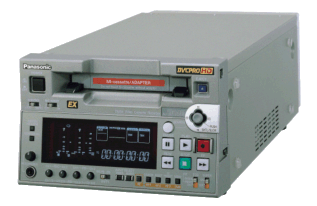
Panasonic
DVC Pro HD
|
|
|
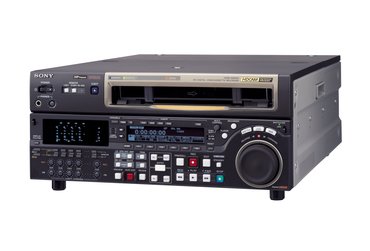
Sony HDW-2000 HDCAM Studio Deck |
|

Sony HDW-250 HDCAM Portable Deck |
|
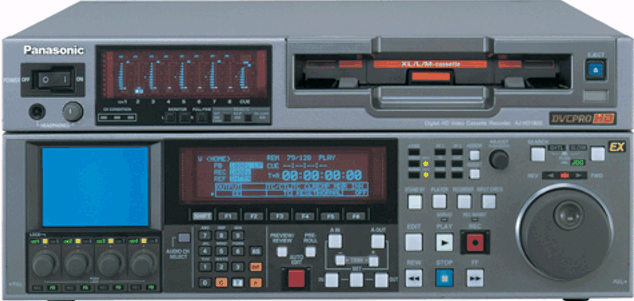
Panasonic AJ-HD1800 DVCPro HD Recorder
|
|
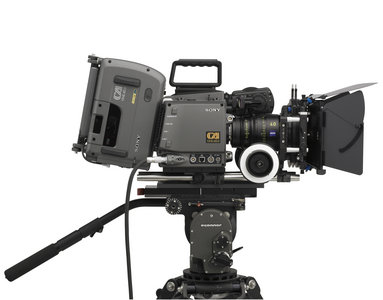
SRW-1 mounted on a Sony F-23

SRW-1 Connected to an F-23 using a Fiber Optic Link
|
| Videotape
Advantages |
Videotape
Disadvantages
|
| Simplicity of Loading and Unloading
Longevity of recording (Archival Potential)
Reliability during rugged shooting
Digital format (For HD) for best quality
Easier Media Management during Acquisition
If the Tab is pushed, the videotape can not be recorded over
SRW-1 and SRW-5800 Recorders allow for huge Recording Bandwidth for
low video compression and very high quality pictures.
Very simple to ship anywhere in the world and is not subject to
breakage due to being dropped or roughly handled when in a properly
packed shipping container. |
Mechanical Process and is subject to failure.
Transfers to Hard Drive Editing Systems can be time consuming
Limited Bandwidth recording for most formats, reducing recording
quality
Subject to Temperature and humidity restrictions during recording,
playback, and storage
Media can be accidentally
recorded over during the acquisition process if the
Camera Operator or Assistant reviews a recording and fails to re-cue the
tape to an unrecorded section |
|
Optical Disk |
| Optical Disk was Sony's way of increasing
their revenue by adding a new recording format for video, but one that
was strictly an intermediary to keep Sony in the recording Medium
business as videotape's limitations became evident, and thus Sony
revenue would fall.
Sony introduced this format to give greater bandwidth over videotape,
and allow for digital recording. The disks are reusable, however,
their overall life is really unknown. This format is limited to
Standard Definition and Sony no longer manufacturers cameras or playback
devices for this media. |
|
| Optical
Disk Advantages |
Optical
Disk Disadvantages |
| None - format discontinued. |
The Medium is Optical and subject to
contamination in the acquisition Process.
This recording format will be phased out in the near term as it is
replaced by memory card and hard drives. time so the value of past
recordings is greatly limited |
|
Hard Drives |
| Hard Drives have been a
Post-Production Standard for years, but the original cost was far too
high and their tendency to be too delicate for use as a acquisition
format.
But times and technology have changed. The recording
capacities
have risen, the costs have come down, and the ruggedness has improved.
Each camera system has their own recording attachment requiring the
acquisition of the Hard Drives from the camera manufacturers, so cost is
going to be higher than your average computer Hard Drive.
They also require mounting hardware and often operate using proprietary
software and recording technologies.
But Hard Drives do have their limitations. Once again, these
are mechanical devices subject to failure. In fact, a Hard Drive
failure potential is much greater than videotape. If the camera
with a Hard Drive is operating in a rugged environment there is a strong
chance the hard drive can be damaged, or the recording can be
compromised.
But Hard Drives allow for faster downloads to editing systems, and
can be backed up relatively easily. NEVER EVER ship a Hard Drive
via Federal Express, UPS, or other courier without first making at least
one, preferably two back ups. Shipping always subjects the drive to a harsh, rugged
environment, and the potential for damage to the Hard Drive is
significant.
Hard Drives are subject to Mechanical Shock conditions. If the
camera is going to be mounted on a tripod, dolly, Steadicam, Camera
Crane, in a studio, or on the street, then the Hard Drive offers
exceptional value and ease of acquisition. It can be used in
most hand-held configurations as long as the camera is not
subjected to enormous forces.
Hard Drives provide high quality recording, and
allow for enormous
bandwidth depending on the camera and recording format being used.
However, if you are shooting in a rugged environment, in which the
camera is going to be subject to heavy vibration or physical shocks,
the hard drives CAN NOT be mounted on the camera. A remote or
independent recording device connected to the camera via cable must be
used and the hard drives must be in a buffered or protected environment
to prevent physical abuse.
Often the Hard Drives are not even mounted on the cameras, instead
they are attached to a Crash Cart, or to an independent Recording
system, via one or two high bandwidth coax cables. Whenever cables
are added there is an additional potential for failure as the
connectors on cables can be pulled off if the cable gets caught on
something . In addition, cables are limited in the length they can
be as the signal loss becomes too great. Usually this length is
limited to 30 to 50 meters (90 to 150 feet), depending on the cable and
camera.
The best method is to mount the hard drives directly on the camera,
however, this usually requires proprietary hard drives from the camera
manufacturer. This increases the cost to the rental house, which
it then passes down to the producer as a higher rental fee. In
addition, if you run out of hard drives or one or more fail, you have to
go to a rental house with these specific hard drives. This places
a huge burden on the producer, especially those shooting on a shoe
string budget.
Sony has developed the XDCam Hard Drive (Disk) Recording system in
which the Disk can be removed, and the mechanical writing system remains
in the camera. This recording technology has limited Bandwidth
(Generally 50 MBs) but reduces the potential for catastrophic Hard Drive
failure. It records in the 4:2:2 format so it is best limited to
broadcast television production.
XDCAM
The XDCam Disk holds a large volume of data (23 GB) and can be
removed from the camera just like videotape. It has a tab to
prevent any potential for accidentally recording over
material. The only disadvantage to this system is the
Bandwidth. For most television productions this format is very
affordable. You also have the potential to cost-effectively
archive the camera masters, or easily erase and reformat the disk for
new acquisition.
XDCam should not be used for feature film production,
as it's bandwidth is not really good enough and it only records in 4:2:2
format. It is acceptable, but not preferable for commercial
production, and really shines for Reality Shows. |
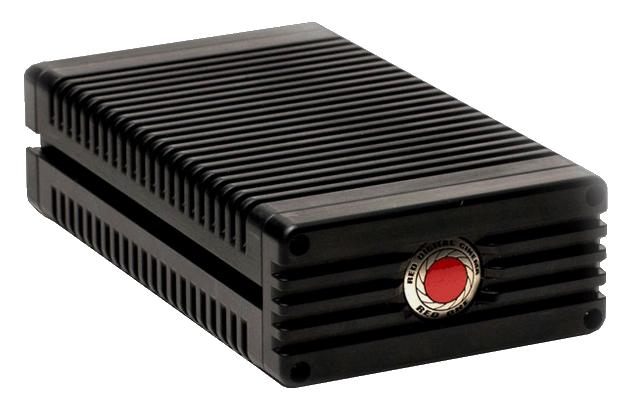
Red Hard Drive Recorder
|

AJA
Ki-Pro |
|
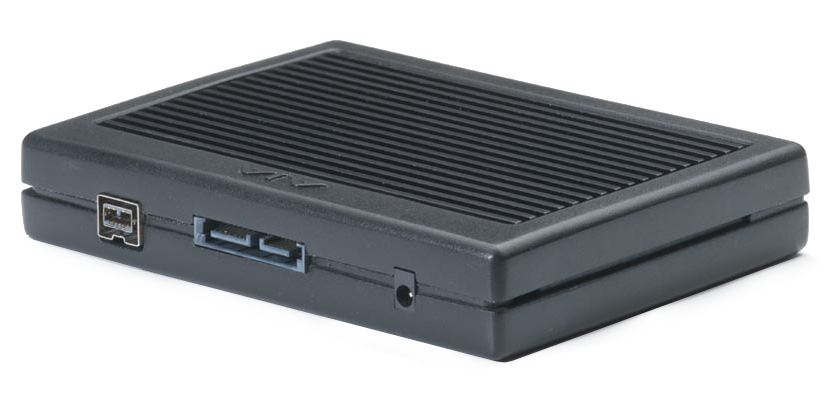
Ki-Pro 500 GB Drive |
|
|
|
|
|
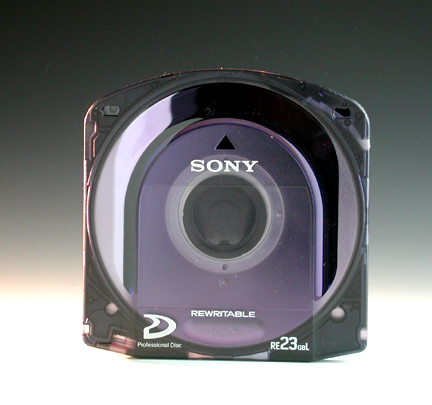
Sony XD Cam Removable Hard Drive
|
|
| Hard
Drive Advantages |
Hard
Drive Disadvantages |
| Simplicity when hard drive is mounted on
camera
Fast Transfers to editing systems (Digitizing)
Unlimited Bandwidth potential (depending on camera and recording
software)
Can be mounted Directly on the camera, allowing for true film
operation.
Offers 4:4:4 recording capability |
Mechanical devices subject to failure.
Can Not be Used in a rough environment when mounted directly on a
camera.
Hard Drives capable of being mounted directly on the camera are often
proprietary devices and must be purchased from the manufacturer.
This limits the number of hard drives available
Shipping must be done carefully and back ups made. |
|
Memory Cards |
| There are several
variations of memory
cards. Some use proprietary software and/or hardware, while others
use common Memory Card formats.
Memory Cards, commonly referred to as Compact
Flash Cards are for
most productions requiring the most robust and sophisticated new media recording
approach.
These cards offer a tape less
environment, but, unlike Hard Drives, these units are not subject to
shock abuse and have the capability of being mounted in series so, as an
example, four 64 GB Memory Cards have the equivalent of 256 GB recording
capacity. They can be hot swapped without having to stop recording
(the card currently being recorded on can not be removed, but the others
can be) so they have the capability of lasting almost forever.
With the introduction of 64 GB loads, the Memory Card has now reached a
performance level that makes them practical for almost every
application.
Because Most Camera Manufacturers have
made their memory cards proprietary ( Sony uses the Memory Stick, while
Panasonic uses the P2 Card), these cards cannot be interchanged.
The
Panasonic P2 Card The
Panasonic P2 card is being phased out and replaced with other more
common memory cards, such as the Compact Flash and SD Card. The Panasonic P2 Card began the
Memory Card revolution as a camera acquisition media. The P2 has
evolved and is now available with up to 64 GB of storage on a single
card. Depending on the camera, it can record in all formats
including: NTSC, PAL, 1080/23.98 psf, 1080i, High Speed recording,
etc. Also capable of recording both 4:2:2 and 4:4:4, making it acceptable for use in
productions requiring significant color accuracy, such as for Chromakey. This
card offered the Producer the first digital media with full HD quality,
however it is a proprietary device so it can only be used with a Panasonic
Camera or recording device. The Panasonic series of cameras offer excellent picture and color
quality, and meet the needs of any broadcaster, or internet delivery
requirement. The
SD Card The SD
Card is the best flash memory drive for many, but not all video
acquisition devices. Like all flash drives there are two factors
to consider when electing, the capacity, and the write speed. The
capacity is obvious, but what must be careful considered is the write
speed. The higher resolution the camera and the less compression
used, the more data that must be transferred to the memory. Because
there is a large amount of data being transferred to the card, it must
have a very high writing speed, limiting the brands and variations that
can be used on some brands of cameras. The
Compact Flash Card Just
like the SD Card, The Compact Flash Card is excellent for most, but not
all video acquisition devices. Once again you must consider
the capacity, and the write speed. Many 2K and 4K and greater
Cameras are designed to work with Compact Flash Cards, as they have very
good write speeds and significant capacities.
SSD
(Solid State Disk)
SSD Drives are like
computer hard drives, except there are no mechanical parts, so the
stability and reliability of the recording medium is significantly
better. These drives are designed for a high volume of data and
thus are recommended for most Raw Data Recordings. When shooting
in 4K or higher resolutions, the SSD card is really the only
choice. The write speeds for all other mediums is just not fast
enough.
Memory
Card Info
Like
videotape most memory cards have a tab which prevents additional
recording on the card. This is especially critical when dealing
with Media transfer management to prevent accidental reformatting of
memory card before transfer to Hard Drive. Memory
Cards often require a person on set who should be devoted to media transfer to
Hard Drives. It is critical that these transfers be done properly
and that at least two hard drives are used for the transfer
process. One hard drive must be marked as Master, with the other
stored away as a protection in the event the master should fail. The
alternative to having someone on set doing the transfers is to purchase
or rent a large quantity of Flash Cards Once
transferred to Hard Drive, the memory card is then reformatted and
placed back into the camera for re-recording. Once the card has
been reformatted there is no potential for data recovery if there was a
problem transferring the data to Hard Drive. Hard
Drives have the potential to be long term archival devices, as long as
the hard drive is stored in an anti-static bag and a non-magnetic and
non-radiation environment. How long a hard drive will hold the
data is up for debate, but with the cost of hard drives is dropping
making it very cost-effective to maintain two hard drives for
archiving. The Master and Protection Hard Drives should be stored
in two different locations so if there is a fire or some other
catastrophic event there is a strong likelihood the other drive will
survive if one is damaged. There
is no official source as to how long a hard drive will retain it's data,
if not powered and not running while being stored. Some say 5 years,
some say 20, others say indefinitely. Even the manufacturers
opinions vary. For any project
considering using a Memory card, especially for cameras like the Red,
the card must be considered like a film magazine. Once shot, the
magazine has to be unloaded, and then reloaded and sent back to the
set. The same is true with the Memory Card. Once the Card is
full, it is sent to a media transfer specialist, who "unloads"
the data from the card, and then once transferred to at least two hard
drives, the memory card is then "reloaded" by formatting the
memory card, erasing all of the data. The Memory Card is then sent back
to the set for reuse. For Feature Film
Production with reasonable budgets the Memory Card is an excellent media
device for acquisition. When using a camera like the Red One, the
8 GB Memory Card has the capacity to act like a 400 foot film
magazine, and because the data is raw, it allows for sophisticated
and comprehensive manipulation during edit. |
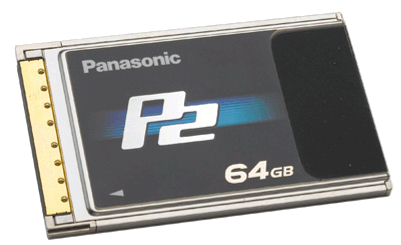
Panasonic P2 Card - 64 GB
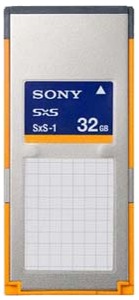
Sony S Xs
Card

SD Card
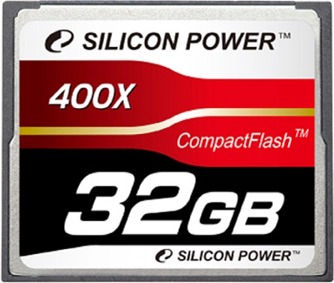
Compact Flash Card
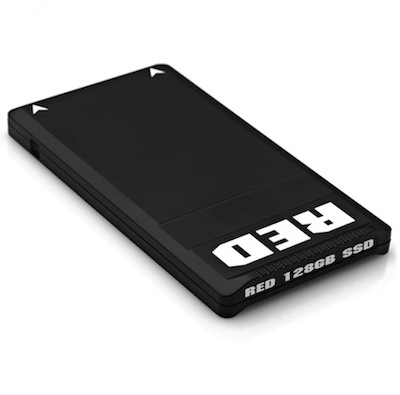
Red SSD Card |
|
|
|
|
|
|
| Memory
Card Advantages |
Memory
Card Disadvantages |
| Simplicity of Loading and Unloading
Fast Transfer to Hard Drives
Reliability during rugged shooting
Digital format (For HD) for best quality
Easier Media Management during Acquisition
If the Tab is pushed, the Memory Card can not be recorded over/
The Cards on some brands of cameras have
virtual unlimited recording times because of the ability to hot swap
Memory Cards that are not currently being recorded on.
Very simple to ship anywhere in the world and is not subject to
breakage due to being dropped or roughly handled when in a properly
packed shipping container.
Unlimited Number of times the Memory Card
can be recorded over without any loss in quality.
Capable of recording 4:4:4 on some brands
of cameras, and 4:2:2 on all cameras.
Technology is continuing to evolve and
will only get better.
Less vulnerable to heat and humidity, but
still has issues with very cold weather. By
Design it is difficult to over record previous recordings |
Very
Expensive to purchase the Memory Cards, but they offer unlimited
re-recording.
Must be Transferred to other Digital
Media such as Hard Drive for storage and forwarding to editing in most
circumstances.
No Archival capability without being
transferred to other Digital Storage devices such as Hard Drives.
Every project requires the purchase of at
least two high capacity hard drives (typically 500 GB for most
non-feature film projects). This adds expense, however, the cost
of these drives is very reasonable, when compared to videotape.
Cards are Proprietary so you must use the
right card for the right camera
Often requires a digital media management
person on the set to download memory card to at least one hard drive.
Content can damaged or lost due to
radiation and magnetic fields
Transfer from Memory Card to Hard Drive
risks loss of data if Hard Drives are damaged or the media was not fully
transferred correctly.
|
| Click
Here to Go to:
Recording
Format Selector |
|
|
Serving Los
Angeles, Hollywood, Burbank, Culver City, Santa Monica, LA,
Downtown Los Angeles, Pasadena, Glendale, Studio City, Sherman
Oaks, County of Los Angeles, County of Orange, Orange County,
Ventura County, Riverside County, Anaheim, California, Santa
Ana, Universal City, Universal Studios, North Hollywood, West
Hollywood, La Mirada, Fullerton, Redondo Beach, Huntington
Beach, Newport Beach, Long Beach, Costa Mesa, Venice, Covina,
Beverly Hills, Malibu, Thousand Oaks, Simi Valley, Moorpark
|
| Specialist in commercial
production, music videos, sit-coms, episodic program, dramatic
programs, movies, features, reality programs, corporate videos,
entertainment specials |
| reality TV, reality show, reality shows,
commercials, music videos, public service announcements, PSAs,
PSA, movies, features, low budget features, low budget
Television, entertainment specials, corporate videos, award
shows, specials, camera cranes, hot heads, hot heds, jimmyjibs,
jimmy jib, cam mate, cammate, technocrane, super techno, Red
Camera, Red One, F-35, F-23, F23, F35, television show,
television shows, helicopter shoot, helicopter photography,
helicopter cinemaphotographer, cinemaphotographer, cinema
photographer, videographer, video grapher, F900, Ikegami, Sony,
Panasonic, HDX-900, SDX-900, HPX500, HPX-500, HPX 500, High
Definition Video, HDTV, High Def, HD Video, High Def Video,
HPX-3000, HPX 3000, HPX3000, HPX2000, HPX-2000, HPX 2000, Jib
Owner/Operator, Owner Operator
|
|
|
| |
|
| |
|
| |
|
| |
|
| |
|
| |
|
| |
|
| |
|
| |
|
| |
|
| |
|
| |
|
| |
|
| |
|
| |
|
| |
|
| |
|
| |
|
| |
|
| |
|
|







































